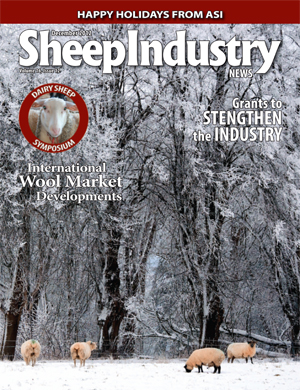
- December 2012
- NSIIC Announces Grants to Strengthen Industry
- Current International Wool Market Volatility
- Dairy Symposium Brings Producers Together
- U.S. Senators Support American Sheep Producers
- Weaving America’s Spirit for Over a Century
- Wildfires Force Ranchers into Tough Choices
- Wildfires Force Ranchers into Tough Choices
- Wool Industry to Recognize Lupton
|
By BARRY SAVAGE (Dec. 1, 2012) Over the last 18 months there has been a significant degree of volatility in the international wool market. It might be useful at this time to have a look at when and where the market lows and highs have been, the relative levels involved and some reasons why the market has been so volatile. The low point for the Australian Eastern Market Indicator (EMI) – the recognized international market indicator – in recent years was in February 2009 when it bottomed out at U.S. 215 cents/lb. clean weight. In June 2011 it peaked at U.S. 687 cents/lb. – a 220-percent increase over that period. The market then began a lengthy slide that bottomed out at U.S. 412 cents/lb. on Sept. 5, 2012 – a 40-percent drop from the market peak, but IMPORTANTLY, it is still 92-percent above the unworkable levels of 2009. Then began a somewhat unexpected, sustained upward correction in the market that lasted until the end of October, peaking at U.S. 492 cents/lb. – some 129-percent above the 2009 level (see EMI graph from AWEX, Australia). As of Nov. 7, the market indicator has softened a little to U.S. 487 cents/lb., so we will have to wait to see if this will be a new level or not. By any measure, this is a very volatile market situation. While some moderate volatility is not a bad thing in commodity markets, large swings create market confidence issues, make those swings larger than they otherwise might be and are certainly unhealthy for our industry – especially for wool growers. There are, of course, a number of factors that influence market movements, both at the macro-level and the micro-level.Supply and Demand: The world wool supply is at its lowest level in 50 years. This means that even moderate shifts in demand causes more exaggerated price movements than might be the case in more balanced conditions. Consumer Confidence: Wool demand at the consumer level has seen some very significant changes over recent years. Once some consumer confidence returned after the 2008-2010 global financial crises, textile purchases picked up significantly in all major markets – the United States, Europe and especially in the rapidly expanding China domestic market. Wool prices moved up very rapidly amid fears of lack of supply to the June 2011 peak of U.S. 687 cents/lb. Worldwide Market Conditions: From 2010-2011, the world experienced a kind of “triple whammy” that impacted consumer confidence and market conditions worldwide. The U.S. debt crisis followed by the European debt crises and the tightening of credit facilities in China as they looked to slow their rate of growth to avoid inflation, all led to a slowdown in retail textile purchases for not only wool, but all fibers. This combination of factors has had an especially strong impact in China that has seen both its clothing exports drop (20 percent for the first eight months of 2012 according to Landmark) and its domestic market contract. The result has been a significant reduction in raw fiber purchases by China. As China buys approximately 61 percent of the world’s raw and semi-processed wool exports, (including up to 63 percent of U.S. wool exports), this has been the fundamental cause of the recent large drop in wool prices worldwide. Industry Confidence: One of the key micro-level factors in a commodity market is the confidence level of the industry participants. This is even more so when the number of key players really is quite limited. If there is a pervading feeling in the market that the downward direction of the market will continue, no wool buyer or user will buy anything beyond what is absolutely necessary to feed his needs in the short term. It was very clear at the Nanjing Wool Market Conference in Sanya, China in early September that this was exactly the situation for both the Chinese manufacturers and their suppliers. While Chinese early stage processors’ stocks were not high, stocks of yarn and fabric were said to be enough to sustain the market for at least a short while. It would appear that by the beginning of October, stocks worldwide were reaching a critical point where either some renewed purchasing would have to occur or some processing/manufacturing capacity would have to close. Exporters report that, while China led the way, as might be expected, there was also some support from Italian woven goods manufacturers, particularly at the finer-micron end that had seen very significant price drops over the last year. At an even deeper micro-level, the number of raw-wool exporters worldwide who are large enough to make a significant move into the market is now relatively small (in Australia that number is arguably around six). If one or two of these companies start to buy “significant” quantities after a sustained period of sluggish activity in the market, others may well feel the need to at least “cover up” their wool position, if not add some stock as a buffer against rising prices. The market signals over the last month would suggest that there are not significant stocks of raw material worldwide and we may be at, or near, the market bottom in the short term. However, economic conditions in the major wool-consuming countries remain subdued and difficult. Therefore, it seems likely that retail sales over the next three months will remain sluggish and that a moderate recovery in some major retail markets (notably the United States), better consumer confidence and wool price competitiveness will lead to a slow, but steady, improvement in wool demand in the second half of 2013 (Landmark). |
|

